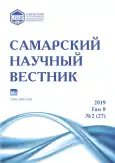К вопросу о положении женщин дальневосточных сёл в период «позднего» социализма
- Авторы: Гринько А.А.1
-
Учреждения:
- Дальневосточный государственный аграрный университет
- Выпуск: Том 8, № 2 (2019)
- Страницы: 292-295
- Раздел: 07.00.00 – исторические науки и археология
- URL: https://journals.rcsi.science/2309-4370/article/view/34332
- DOI: https://doi.org/10.17816/snv201982228
- ID: 34332
Цитировать
Полный текст
Аннотация
В статье рассматривается трансформация положения женской части сельского населения Дальнего Востока СССР в 1970-х - первой половине 1980-х годов под влиянием целого ряда причин. Особенности географического положения региона, уровень его развития, ускорение процессов жизнедеятельности на селе, быстрое распространение информации и другие факторы оказывали значительное влияние на сельских женщин. Это влияние было противоречивым и неоднозначным. С одной стороны, изменялась роль женщины в семье, возрастала ее активность как работника, повышалось благосостояние, культурный и образовательный уровень, но, с другой стороны, становясь более независимой, женщина стремилась к лучшим условиям труда и жизни, карьерному росту, увеличению свободного времени для отдыха, что в сельской местности было затруднительно. Несмотря на особое внимание государства к Дальнему Востоку и проведение мероприятий, направленных на развитие сельской местности, жизнь в деревнях не отвечала «урбанизированным» взглядам местных жительниц. Результатом такой трансформации стала ориентация на малодетность для значительной части молодых сельчанок и переезд в городскую местность, воспринимаемую на фоне села как несравнимо лучшее место жительства.
Полный текст
Открыть статью на сайте журналаОб авторах
Андрей Александрович Гринько
Дальневосточный государственный аграрный университет
Автор, ответственный за переписку.
Email: andrey2007-85@mail.ru
кандидат исторических наук, доцент кафедры гуманитарных дисциплин
Россия, БлаговещенскСписок литературы
- Возрастной состав населения Приморского края (по данным всесоюзной переписи 1979 г.). Владивосток: Краевое управление статистики, 1980. 142 с.
- Российский государственный архив экономики (РГАЭ). Ф. 1562. Оп. 56. Д. 2736.
- Проблемы демографического развития Сибири и Дальнего Востока: сб. науч. тр. / под ред. С.В. Соболевой. Новосибирск: Наука, 1991. 162 с.
- Амурский статистический ежегодник. Благовещенск: Статуправление, 2008. 166 с.
- Государственный архив Амурской области (ГААО). Ф. 480. Оп. 15. Д. 888.
- Социально-экономические проблемы дальневосточного села. Владивосток: Дальнаука, 1987. 189 с.
- Хабаровскому краю - 60 лет. 1938-1998. Хабаровск: Статуправление, 1998. 98 с.
- Решения партии и правительства по хозяйственным вопросам: сб. документов. Т. 14. М.: Политиздат, 1984. 703 с.
- Постановление ЦК КПСС и Совета Министров СССР от 22.01.1981 г. «О мерах по усилению государственной помощи семьям, имеющим детей» [Электронный ресурс] // https://base.garant.ru/3999170.
- Государственный архив Российской Федерации (ГАРФ). Ф. 374. Оп. 39. Д. 6189. Л. 136.
- Женщины в Амурской области. Благовещенск: Статуправление, 1979. 54 с.
- ГАРФ. Ф. 374. Оп. 39. Д. 6214. Л. 19.
- Российский государственный архив социально-политической истории (РГАСПИ). Ф. 591. Оп. 1. Д. 127. Л. 32.
- ГААО. Ф. 480. Оп. 12. Д. 142.
- Геллер М.Я. Машина и винтики. История формирования советского человека. М.: МИК, 1994. 336 с.
- Государственный архив Приморского края (ГАПК). Ф. П.-68. Оп. 50. Д. 429. Л. 48, 109.
- Социально-экономический анализ уровня жизни населения Дальнего Востока / отв. ред. С.В. Югай. Владивосток: Дальнаука, 1989. 268 с.
- Денисова Л.Н. Исчезающая деревня России: Нечерноземье в 1960-1980-е годы. М.: Институт российской истории РАН, 1996. 215 с.
- РГАСПИ. Ф. 17. Оп. 153. Д. 1089.
Дополнительные файлы






